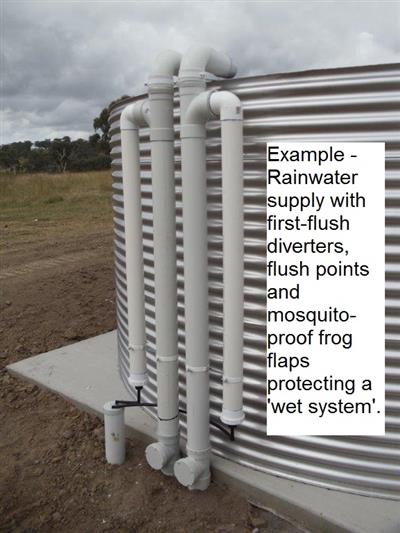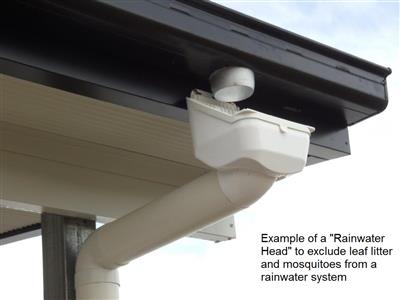Installing a rainwater tank saves both water and money. A rainwater tank provides:
- Free water, saving money on rates;
- Soft water that lathers easily, saving soap and detergent; and
- Extra water available for hosing down your house, washing cars, watering gardens, etc.
 The current view of many health authorities is that while rainwater from a well-maintained system is a useful source of water, it is not recommended for drinking water use and additional treatment may be desirable, particularly in urban areas, for uses that involve human contact.
The current view of many health authorities is that while rainwater from a well-maintained system is a useful source of water, it is not recommended for drinking water use and additional treatment may be desirable, particularly in urban areas, for uses that involve human contact.
High quality tank water is dependent on the owner’s maintenance regime of a healthy tank. Proper maintenance involves the cleaning of gutters and downpipes and checking for mosquito and vermin control. Tank installation could include a ‘first flush’ system to divert the initial scour of dirty rainwater away from the tank.
If water is only to be used for non-drinking purposes, such as in washing machine or toilet, then it is unlikely that any treatment will be required, although filtering does limit some contamination. If water is to be provided for other household uses that involve contact with humans, such as drinking, showering or cooking, additional treatment should be considered, potentially ultra-violet disinfection.
While Council supports rainwater harvesting for domestic purposes, it is not suggested that tank water replace available town water supply for drinking purposes. There is no guarantee that every resident installs, cleans and maintains rainwater tanks correctly to ensure safe drinking water.
Public Health Concerns
Approximately 3 million Australians currently use rainwater for drinking with very few reported incidences of ill health. This is in spite of a number of reports that have shown that water often fails to meet microbiological guidelines for drinking water quality because of contamination by animal faeces, vegetation and air-borne pollution.
The current view of many health authorities is that while rainwater from a well-maintained system is a useful source of water, additional treatment may be desirable, particularly in urban areas. If plumbed into the drinking water (town drinking water) system, back-flow prevention is an essential barrier to protect the drinking water system from possible contamination. Roofing materials may also influence water quality. Tanks must be installed in accordance with plumbing standards.
To help ensure the integrity of your rainwater tank, the quality of the collected rainwater, and the safety of the community against disease, follow the simple maintenance checklist.
Tank water safeguards
When installing a rainwater tank, attaching several simple devices may assist in keeping water quality in reasonable condition: 
- Gutter guards prevent leaf litter entering the tank
- Rainhead diverts leaves
- First flush diverter redirects the first polluted flow
- Mosquito and insect screens are required to be fitted on all rainwater tanks
- Filters provide additional protection
Backflow prevention device
A backflow prevention device prevents untreated water contaminating the town water supply. If there is an interconnection between the rainwater supply and the town water service supplying the outlet valve at fixtures and appliances, such as toilets and washing machines, an appropriate backflow prevention device must be installed to protect against the untreated water in the tank accidentally contaminating the town water supply, by a suitably qualified ‘backflow endorsed’ licensed plumber.
Positioning of the tank outlet
The outlet should always be above the base of the tank to avoid drawing off sediment that has settled at the bottom of the tank over time. The tap or outlet should be marked ‘rainwater’ in accordance with Australian standards.
Rain water tank maintenance checklist
Regular inspection of your tank is recommended.
- Monthly inspection: This should include checking the tank strainer and tank overflow screen for any breakage where mosquitoes can enter. Clean these monthly throughout summer wet season and three monthly from Autumn to Spring.
- Three monthly inspections: Check and clean first flush devices, and leaf guards on rainheads. Check the roof and clean gutters of plant material and other potential contaminates. If large amounts of plant material and other potential contaminants are found, then inspection and cleaning should be more frequently, especially after heavy rainstorms. Prune overhanging tree branches and foliage.
- Six monthly inspections: Check tank for defects and repair. Visually check water quality; ensure water is clear and contains no unusual smells. Check for evidence of animal, bird or insect access including mosquito larvae; if such evidence is present, locate and close these access points. Check for algal growth, if present, find and close all sources of sunlight infiltration. Ensure all rainwater outlets have the correct signage.
- Annual: Check tank structure and base for structural integrity. Remove accumulated sediment sludge from inside the base of the tank.
Additional Information